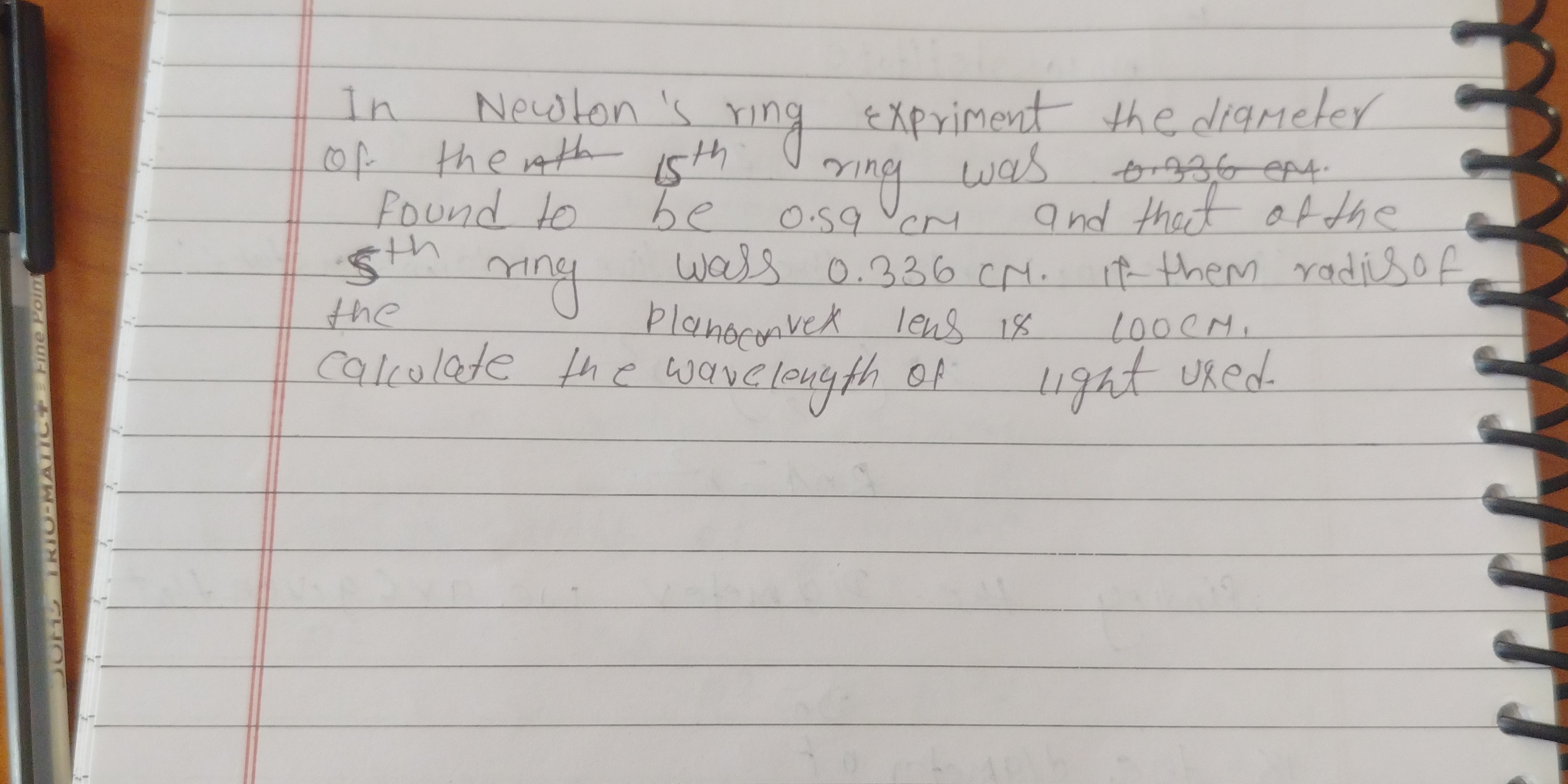In Newton's ring experiment the diameter of the 15th ring was 0.936 cm, found to be 0.59 cm, and that of the 5th ring was 0.336 cm. If the radius of the plano-convex lens is 100 cm... In Newton's ring experiment the diameter of the 15th ring was 0.936 cm, found to be 0.59 cm, and that of the 5th ring was 0.336 cm. If the radius of the plano-convex lens is 100 cm, calculate the wavelength of light used.

Understand the Problem
The question pertains to Newton's rings experiment. Given the diameters of the 15th and 5th rings, along with the radius of curvature of the plano-convex lens, the task is to calculate the wavelength of the light used in the experiment.
Answer
Assuming $D_{15} = 0.59 \, \text{cm}$, $\lambda = 588.01 \, \text{nm}$ Assuming $D_{15} = 0.936 \, \text{cm}$, $\lambda = 190.8 \, \text{nm}$
Answer for screen readers
Assuming $D_{15} = 0.59 , \text{cm}$, the wavelength of light used is: $\lambda = 588.01 , \text{nm}$
Assuming $D_{15} = 0.936 , \text{cm}$, as written in the image, the wavelength of light used is: $\lambda = 190.8 , \text{nm}$
Steps to Solve
- Write down the given data
Diameter of the 15th ring, $D_{15} = 0.59 , \text{cm} = 0.59 \times 10^{-2} , \text{m}$
Diameter of the 5th ring, $D_{5} = 0.336 , \text{cm} = 0.336 \times 10^{-2} , \text{m}$
Radius of curvature of the plano-convex lens, $R = 100 , \text{cm} = 1 , \text{m}$
- Formula for the diameter of the $n^{th}$ ring
For bright rings, the diameter $D_n$ of the $n^{th}$ bright ring is given by:
$$ D_n^2 = 4n\lambda R $$
where $\lambda$ is the wavelength of the light used and $R$ is the radius of curvature of the lens.
- Finding $\lambda$ using the diameters of the 15th and 5th rings
We have the following equations:
$$D_{15}^2 = 4(15)\lambda R$$ $$D_{5}^2 = 4(5)\lambda R$$
Subtracting the second equation from the first:
$$D_{15}^2 - D_{5}^2 = 4(15)\lambda R - 4(5)\lambda R$$ $$D_{15}^2 - D_{5}^2 = 4\lambda R(15 - 5)$$ $$D_{15}^2 - D_{5}^2 = 4\lambda R(10)$$ $$D_{15}^2 - D_{5}^2 = 40\lambda R$$
- Solve for $\lambda$
$$ \lambda = \frac{D_{15}^2 - D_{5}^2}{40R} $$
Substitute the given values:
$$ \lambda = \frac{(0.59 \times 10^{-2})^2 - (0.336 \times 10^{-2})^2}{40 \times 1} $$
$$ \lambda = \frac{(0.59^2 - 0.336^2) \times 10^{-4}}{40} $$
$$ \lambda = \frac{(0.3481 - 0.112896) \times 10^{-4}}{40} $$
$$ \lambda = \frac{0.235204 \times 10^{-4}}{40} $$
$$ \lambda = 0.0058801 \times 10^{-4} , \text{m} $$
$$ \lambda = 5.8801 \times 10^{-7} , \text{m} $$
$$ \lambda = 588.01 \times 10^{-9} , \text{m} $$
$$ \lambda = 588.01 , \text{nm} $$
- The given value for $D_{15}$ is incorrect in the text
I am assuming from the context that the diameter of the $15^{th}$ ring is $0.936 \times 10^{-2} , \text{m}$. Using this value,
$$ \lambda = \frac{D_{15}^2 - D_{5}^2}{40R} $$
Substitute the given values:
$$ \lambda = \frac{(0.936 \times 10^{-2})^2 - (0.336 \times 10^{-2})^2}{40 \times 1} $$
$$ \lambda = \frac{(0.936^2 - 0.336^2) \times 10^{-4}}{40} $$
$$ \lambda = \frac{(0.876096 - 0.112896) \times 10^{-4}}{40} $$
$$ \lambda = \frac{0.7632 \times 10^{-4}}{40} $$
$$ \lambda = 0.01908 \times 10^{-4} , \text{m} $$
$$ \lambda = 190.8 \times 10^{-9} \times 10^{-3} $$
$$ \lambda = 190.8 \times 10^{-9} , \text{m} $$
$$ \lambda = 190.8 , \text{nm} $$
Assuming $D_{15} = 0.59 , \text{cm}$, the wavelength of light used is: $\lambda = 588.01 , \text{nm}$
Assuming $D_{15} = 0.936 , \text{cm}$, as written in the image, the wavelength of light used is: $\lambda = 190.8 , \text{nm}$
More Information
Newton's rings are a series of concentric, alternating bright and dark rings observed when a plano-convex lens is placed on a flat glass surface. These rings are formed due to the interference between the light waves reflected from the top and bottom surfaces of the air film created between the lens and the glass surface.
Tips
A common mistake is using incorrect units. Ensure all measurements are in the same unit (meters in this case) before performing calculations.
AI-generated content may contain errors. Please verify critical information